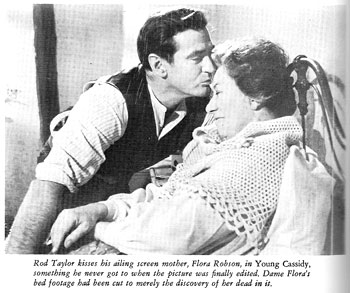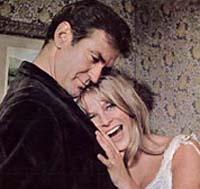|

|
|
Young Cassidy (1965)
Rod Taylor plays Johnny Cassidy in this movie based upon the autobiographical
writings of Irish author Sean O'Casey. (Cassidy is the name O'Casey gives
himself in his third-person writing.)
Taylor considers this to be one of the most important films of his career,
and many consider it to be his finest performance. For example, a 1965 review
in Variety magazine said:
Young Cassidy ... is notable principally for the top-rate
performance of Rod Taylor in title role. ... Taylor delivers a fine, strongly-etched
characterization, believable both in his romantic scenes and as the writer
who comes up the hard way.
BEHIND THE SCENES
Before O'Casey died in 1964, he approved the script and bestowed his
blessing on the choice of Taylor, who "combines both the ruggedness
and tenderness that went into Ireland's greatest poet-playwright,"
Life magazine noted in its Feb. 12, 1965, issue.
However, other actors had been considered. The producers wanted Richard
Harris or Peter O'Toole. The initial director of the film, John Ford, wanted
Sean Connery. But Ford wound up casting Rod Taylor and hit it off immediately
with the rugged Australian.
Taylor, in fact, said he had "the impertinence" to talk Ford
out of making the movie one of his black-and-white art films. In "Print
the Legend," a biography of Ford by Scott Eyman, Taylor is quoted as
telling the director:
I said, "You're going to shoot this in black and
white, in Ireland, where the colors are magnificent? You're out of your
mind. You have to shoot it in color."
Filming began -- in color -- but Ford didn't last long as the director.
Already in frail condition, Ford's health failed quickly. Part of the reason,
Eyman noted, was that Ford was "getting drunk, heading out for the
pubs of Dublin every night in a vain attempt to keep up with the energy
and drinking capacity of Rod Taylor, nearly 35 years younger."
On the set, Ford gave Taylor little actual direction because, as Eyman
wrote, "Taylor was one of the authentic, two-fisted types that [Ford]
liked." Taylor relates an example:
He'd say, "You know what the fuck you do in this
situation. You love this girl. I don't have to tell you anything. Let's
see a little bit of you."
After about three weeks of filming, Ford left the picture, and Jack Cardiff
was summoned to finish. It was a difficult task -- matching another director's
style and intent. The best indication of success is that both men's names
are on the final release: A John Ford Film -- Directed
by Jack Cardiff.
Of all the compliments Rod received for "Young Cassidy," the one he
cherishes the most is a note from John Ford, saying: "Your performance
could have gotten tears from a rock."
Cardiff thought well of Taylor, too, as he wrote in his memoir, "Magic
Hour":
Rod Taylor and I became good friends on "Young Cassidy"
and I directed two more films with him: "The Liquidator" and
"The Mercenaries."
In his book, Cardiff also described getting the call to take
over "Young Cassidy" after director John Ford had fallen ill:
I was urgently summoned to Ireland
to take over the film -- a daunting task, not having even read the
script, nor met the glittering cast, which included Rod Taylor, Julie
Christie, Edith Evans, Michael Redgrave, Maggie Smith and Flora Robson.
It turned out to be a most creatively satisfactory experience. It was a
joy to work with such a fine cast and a great script.
ON THE SCREEN
"Young Cassidy" is the story of a working-class rebel who rises
to literary greatness. The movie unfolds episodically as it spans a dozen
years in the early 1900s.
Some scenes are astonishingly violent, some heart-rending and sweet.
Throughout, Taylor covers an incredible range of emotion -- anger, grief,
love, pride. He's alternately drunken, literary, sexy, fearsome and foolish.
At the opening of the film, Cassidy is a manual laborer, digging ditches
to support his mother (Flora Robson) and sister (Sian Phillips). Cassidy
also is active with the Irish revolutionary movement against the occupying
British. He uses his writing skills on leaflets to rouse Dublin workers.
Cassidy also finds time for romance, notably with street wench Daisy
Battles (Julie Christie), followed by the more serious bookstore merchant,
Nora (Maggie Smith).
Taylor says that Ford adored Christie: "He was like Hitchcock with
Tippi Hedren -- 'Give her more scenes, she's wonderful.' " But just
as in "The VIPs," it's the scenes with
Maggie Smith that are most magical. I think I will never tire of watching
Cassidy croon to Nora upon the riverbank.
But Nora's timid nature can't keep pace with Cassidy's continued rise
in literary circles. He's encouraged by such Irish literary giants as W.B.
Yeats (Michael Redgrave) and Lady Gregory (Edith Evans). He gets a play
accepted at the Abbey Theatre, "The Shadow of a Gunman." The next,
"The Plough and the Stars," causes a near-riot at the theater
and prompts a fight with a longtime friend and protector.
The night finally ends with heart-rending good-bye to Nora. Infused with
emotion and loudly pledging their love, the two nevertheless pull farther
apart and Nora flees. Cassidy then sets out for England, alone, to achieve
fame and fortune.
FORD OR CARDIFF?
When the critics weighed in on "Young Cassidy," they reserved
their praise for the original director: "There are some very good things in
this movie, obviously the work of John Ford. But the second and "real"
director, Jack Cardiff, measured it out -- only four and a half minutes of the
total two-hour film were directed by Ford.
Two Ford scenes were the fight in the pub and scene following the funeral of Cassidy's mother.
Author Scott Eyman described the latter in his biography of John Ford,
"Print the Legend":
Taylor crept up to a hawthorn tree ... sank to his knees
and started to sob. The shot went on and on, and Taylor began to grow uncomfortable.
Finally, through his tears, he said, "Jesus Christ ... cut."
Ford rose out of his chair, walked over to Taylor and
kicked him in the shins. "You son of a bitch Aussie," he said.
"You made me cry. That's a wrap!
The rest, presumably, was shot by Cardiff. In his autobiography, "Magic
Hour," Cardiff wrote about being dismayed that critics attributed some of
his best work to "the master, John Ford."
I was proud of a sequence I directed of a rioting crowd in the Dublin streets. It took three days to
shoot with several cameras and I cut the scenes in very short sections -- sometimes just a few frames -- to underline the panic and
horror. I supposed I should have been
flattered that my work should be considered to be the work of the master, but
in fact I was indignant. ... I wrote blistering letters to the critics,
but it never does any good.
MISSING SCENE In his 1972 book, "The Unkindest Cuts,"
author Doug McClelland, chronicles scenes left on the cutting room floor. Here's
what he had to say about "Young Cassidy":
Dame Flora Robson had her role as the poverty-stricken mother of the young Sean O'Casey ... slightly snipped. In this brawling, sentimental look at Irish life at the time of the Trouble, Miss Robson died half-way through and was seen in the bed only when her son (Rod Taylor) discovered her there, dead. There is a still showing her sitting up in bed, hardly ready for a jig but very much able to enjoy a kiss on the forehead from her doting son, a scene cut from the release print.
Here's that still photo to which McClelland refers and included
in his book:  |
|

Click
for Gallery


More
images in the Gallery


|
VIEWER'S GUIDE
|
|
DVD on Amazon.com
Sean O'Casey: The Spirit
of Ireland promotional short on YouTube |
|
|
|
WHY CASSIDY? |
|
"Young Cassidy" is based on the life of Irish playwright
Sean O’Casey. He started life as John Casey (born 1880), but he has used many
names. When he started learning Irish, he used Sean O'Cathasaigh, then turned
that into Sean O'Casey as he began to do more writing. However, in the first
volume of his autobiography (1939), he called himself Johnny Cassidy. |
|
|
|
JOHN FORD RETROSPECTIVE
|
|
Rod Taylor took part in a panel discussion that capped a
daylong retrospective on the career of John Ford. The May 6, 2001, event was
hosted by the Directors Guild of America (DGA) at the guild's theater complex in Los
Angeles.
A fan who attended the event said that Taylor and actress Maureen O'Hara
told wonderful stories about John Ford and their interaction with the great
director. The panel was moderated by Scott Eyman, author of "Print
the Legend: The Life and Times of John Ford." Other panel members included
actors Anna Lee, Darryl Hickman and Gloria Stuart as well as Dan Ford, John
Ford's grandson.
After the panel discussion, Rod signed autographs in the lobby of the
auditorium. "He was very pleasant and joked around very much like the
old-time movie stars," an attendee reported, emphasizing repeatedly,
"He was very nice to his fans."
DGA
Magazine had an article (PDF) about the John Ford event in its Summer 2001
issue.
|
|